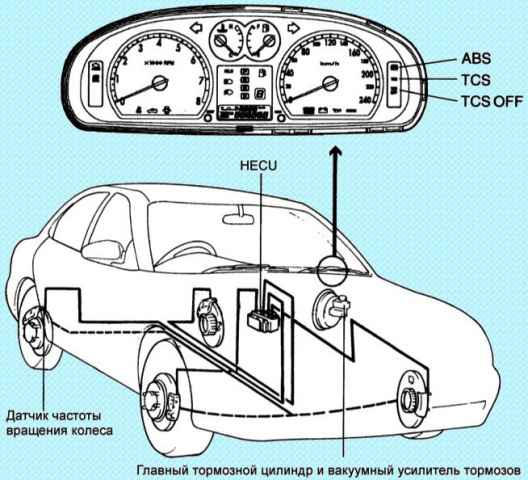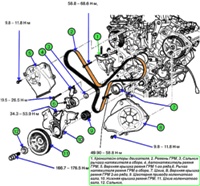Characteristics and malfunctions of the brakes of the Kia Magentis car
Technical data

Brake Master Cylinder
- – type - Tandem
- – cylinder diameter, mm:
- CBS 23.8
- ABS 25.4
Vacuum brake booster
- – type - Vacuum
- – effective diameter, mm:
- CBS 177.8
- ABS 203.2
- – ratio
- CBS 7.0 : 1
- ABS 7.5 : 1
Pressure limiter
- – switch-on pressure, MPa 3.43
- – decompression ratio 0.32 : 1
Front brakes
- – type - Disk, ventilated
- – brake disc diameter, mm 257
- – brake disc thickness, mm 24.5
- – thickness of brake pads, mm 11
- – cylinder diameter, mm 57.2
Rear drum brakes
- – inner diameter of the brake drum, mm 228.6
- – thickness of brake pads, mm 5
- – cylinder diameter, mm 19.05
Rear disc brakes
- – brake disc diameter, mm 262
- – brake disc thickness, mm 10
- – thickness of brake pads, mm 10
- – cylinder diameter, mm 34
Anti-Lock Braking System
ECU control unit
- – supply voltage, V 10–16
- – temperature range, °С – 40…110
Indicator lamp: W / ABS , TCS , TCS OFF , EBD
- – supply voltage, V 12
- – current consumption, mA 80
Wheel speed sensor
- – resistance, Ohm 1275–1495
- – output voltage, V 0.15–50
- – air gap, mm 0.2–1.2
HECU hydraulic unit
- – weight, kg 3.0
- - motor 12 V, 35 A
- – engine power, W 180
- – performance, cm3/ s 5.5
Adjustment data
Height of the brake pedal, 176±0.3 mm
Gap of the brake light switch, 0.5–1.0 mm
Brake pedal free play, 3–8 mm
Distance from the depressed brake pedal to the floor, 44 mm
Gap between the pusher of the vacuum brake booster and the main brake cylinder, mm 0
Parking brake lever travel when tightened to 196 N 8-9 clicks
Minimum allowable front brake lining thickness, 2.0 mm
Minimum allowable brake disc thickness, 22.4 mm
Brake disc runout, 0.08 mm
Minimum allowable brake disc thickness difference, 0.01 mm
Minimum allowable thickness of rear brake pads, 1.5 mm
Maximum allowable bore diameter of the brake drum, 229.6 mm
Maximum allowable piston clearance in the working brake cylinder, 0.15 mm
Minimum admissible lining thickness of rear disc brake pads, 2.0 mm
Lubricants
DOT 3 brake fluid or equivalent
Brake pedal bushing and bolt - Lubricant SAE J 310, NLGI No. 0
Headed Pin with Cotter Pin - Lubricant SAE J 310, NLGI No. 2
Baseplate Contact Surfaces - NLGI No. 0 Bearing Lubricant
Ratchet or ratchet moving parts - Lubricant SAE J 310, NLGI No. 2
Tightening torques, Nm
Nuts for securing the brake master cylinder to the bracket 8–12
Nuts of fastening of an arm of the main brake cylinder 13–16
Vacuum hose fitting to air expansion chamber 15–18
Bleeding port 7–13
Brake pipe union nuts 13–17
Pressure limiter to brake master cylinder 35–55
22-32 caliper guide bolt
Bolts for fastening the caliper to the steering knuckle 69–85
Brake hose to front caliper hollow bolt 25–35
Bolts of fastening of the working brake cylinder 12–18
Front wheel speed sensor 8-9.5
Rear wheel speed sensor 15.5-16.5
Bolts for fastening the ECU control unit and the hydraulic unit HECU 8-10
Bolts for fastening the brackets for the ECU control unit and the hydraulic unit HECU 9–10
Six brake pipes to hydraulic unit 13-17
Brake Troubleshooting
Probable cause
- Elimination Method
When braking, the car pulls to one side
- Grease got on the brake pads
Replace brake pads
- Uneven brake pad contact
Replace brake pads
- Violation of the functioning of automatic brake clearance adjustment pads
Adjust the automatic brake pad adjuster
- Warping or uneven wear of the brake drum
Replace the brake drum
Low braking force
- Low brake fluid level
Add brake fluid
- Air in the brake system
Bleed the brake system
- Overheating of the brakes, leading to a decrease in friction of the brake pads
Replace brake pads
- Grease got on the brake pads
Replace brake pads
- Uneven brake pad contact
Replace brake pads
- Malfunction of the vacuum brake booster
Check the operation of the brake booster
- Violation of the functioning of the automatic adjustment of the gaps of the brake pads
Adjust the automatic brake pad adjuster
- Clogged brake pipe
Clean or replace the brake pipe
- Malfunction of the pressure regulator
Replace pressure regulator
Increased brake pedal travel
- Air in the brake system
Bleed the brake system
- Brake pad wear
Replace brake pads
- Damaged vacuum hose
Replace the vacuum hose
- Brake fluid leaks
Fix brake fluid leaks
- Violation of the functioning of the automatic adjustment of the gaps of the brake pads
Adjust the automatic brake pad adjuster
- Excessive clearance between the push rod of the vacuum brake booster and the main brake cylinder
Adjust clearance between brake booster tappet and brake master cylinder
- Faulty brake master cylinder
Replace the brake master cylinder
Taking the brakes
- Incomplete release of the parking brake
Adjust the parking brake
- Incorrect parking brake adjustment
Adjust the parking brake
- Worn brake pedal return spring
Replace the brake pedal return spring
- Broken rear brake pad tension spring
Replace the spring
- Lack of lubrication in the moving parts of the brake mechanisms
Lubricate the moving parts of the brakes
- Excessive clearance between the push rod of the vacuum brake booster and the main brake cylinder
Adjust clearance between brake booster tappet and brake master cylinder
- The return channel of the main brake cylinder is clogged
Clean the channels of the master cylinder
- Piston return spring damaged
Replace the spring
Unreliable braking of the car with a parking brake
- The brake pads of the rear drum brakes are worn out
Replace brake pads
- Excessive travel of the parking brake lever
Adjust parking brake lever travel or check parking brake cable routing
- Grease got on the brake pads
Replace brake pads
- Violation of the functioning of the automatic adjustment of the gaps of the brake pads
Adjust the automatic brake pad adjuster
- Parking brake cable jam
Adjust the parking brake cable
Noise or vibration when braking
- Worn brake pads
Replace brake pads
- The caliper has play in relation to the wheel
Tighten or replace
- The dust cover has play in relation to the brake disc
Fix or replace
- Brake base plate bent
Repair or replace
- Unevenly worn or cracked brake drum or disc
Replace the brake drum or disc
Squealing or vibration when braking
- Anti-bounce pads are worn out
Replace anti-bounce pads
- Unevenly worn or cracked brake drum or disc
Replace the brake drum or disc
- The brake disc is burred or rusty
Replace the brake disc
- The contact surface of the brake pad is dirty or damaged
Clean or replace brake pads
- In drum brakes, the upper and lower shoe return springs are weakened, the brake shoe retainers or their springs are loose or damaged
Replace damaged elements
V zg while not using the brakes
- The brake shield is deformed with a violation of the gap with the brake drum
Replace
- Poor-quality machining of the brake drum, leading to uneven clearance between the brake shield or pads
Replace the brake drum
- Rusted disc brakes
Clean or replace
- In drum brakes, the upper and lower shoe return springs are weakened
Replace
- Foreign objects in the brake drum
Clean the brake
- Incorrect position of the brake pads in the caliper
Install the brake pads correctly
- Incorrect attachment of the caliper to the caliper holder
Set the caliper correctly
- Incomplete return to the initial position of the vacuum brake booster, main or working brake cylinder
Replace
- The brake pedal or pusher of the vacuum brake booster is incorrectly adjusted
Adjust
Squeaking, clicking or rattling when the brakes are not being used
- Stones or foreign objects got into the decorative wheel cap
Remove stones or foreign objects
- The wheel nuts are not tightened
Tighten the wheel nuts
- Disc brakes - pads damaged
Replace gaskets
- Disc brakes - set bolts not tightened
Tighten the set bolts
- Worn, damaged or dry wheel bearing
Lubricate or replace wheel bearing
- Disc brakes - guide bushing wear
Replace guide bushings
- The brake pedal or pusher of the vacuum brake booster is incorrectly adjusted
Adjust











